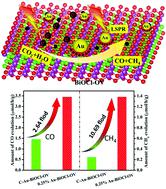Our official English website, www.x-mol.net, welcomes your feedback! (Note: you will need to create a separate account there.)
The simultaneous adsorption, activation and in situ reduction of carbon dioxide over Au-loading BiOCl with rich oxygen vacancies
Nanoscale ( IF 6.7 ) Pub Date : 2021-1-8 , DOI: 10.1039/d0nr08314c Yi-lei Li 1, 2, 3, 4 , Ying Liu 1, 2, 3, 4, 5 , Hui-ying Mu 1, 2, 3, 4, 5 , Rui-hong Liu 1, 2, 3, 4 , Ying-juan Hao 1, 2, 3, 4, 5 , Xiao-jing Wang 1, 2, 3, 4, 5 , Diane Hildebrandt 2, 4, 5, 6, 7 , Xinying Liu 2, 4, 5, 6, 7 , Fa-tang Li 1, 2, 3, 4, 5
Nanoscale ( IF 6.7 ) Pub Date : 2021-1-8 , DOI: 10.1039/d0nr08314c Yi-lei Li 1, 2, 3, 4 , Ying Liu 1, 2, 3, 4, 5 , Hui-ying Mu 1, 2, 3, 4, 5 , Rui-hong Liu 1, 2, 3, 4 , Ying-juan Hao 1, 2, 3, 4, 5 , Xiao-jing Wang 1, 2, 3, 4, 5 , Diane Hildebrandt 2, 4, 5, 6, 7 , Xinying Liu 2, 4, 5, 6, 7 , Fa-tang Li 1, 2, 3, 4, 5
Affiliation

|
The main process of carbon dioxide (CO2) photoreduction is that excited electrons are transported to surface active sites to reduce adsorbed CO2 molecules. Obviously, electron transfer to the active site is one of the key steps in this process. However, current catalysts for CO2 adsorption, activation, and electron reduction occur in different locations, which greatly reduce the efficiency of photocatalysis. Herein, through a spontaneous chemical redox approach, the plasmonic photocatalysts of Au–BiOCl-OV with enhanced interfacial interaction were fabricated for visible light CO2 reduction through the simultaneous adsorption, activation and in situ reduction of CO2 without a sacrificial agent. By loading gold (Au) on the oxygen vacancy (OV), Au and BiOCl-OV formed a direct and tight interface contact, whose fine structure was confirmed by SEM, TEM, EPR and XPS, which not only effectively boosts the light utilization efficiency and the light carrier separation ability, but also can simultaneously adsorb, activate and in situ reduce carbon dioxide for highly efficient visible light photocatalysis. Thanks to the synergistic influence of Au and OV, Au–BiOCl-OV exhibits excellent photocatalytic performance without sacrificial agent and outstanding stability with a high CO and CH4 production yield, reaching 4.85 μmol g−1 h−1, which were 2.8 times higher than C–Au–BiOCl-OV (obtained by traditional NaBH4 reduction). This study proposes a new strategy for the production of high-performance collaborative catalysis in photocatalytic CO2 reduction.
中文翻译:

在富氧空位的载金BiOCl上同时吸附,活化和原位还原二氧化碳
二氧化碳(CO 2)光还原的主要过程是将激发的电子传输到表面活性部位,以减少吸附的CO 2分子。显然,电子转移到活性位点是该过程中的关键步骤之一。然而,当前用于CO 2吸附,活化和电子还原的催化剂出现在不同的位置,这大大降低了光催化的效率。在本文中,通过自发的化学氧化还原方法,制备了具有增强的界面相互作用的Au-BiOCl-OV等离子体激元催化剂,通过同时吸附,活化和原位还原CO 2来减少可见光CO 2。没有牺牲者。通过将金(Au)加载到氧空位(OV)上,Au和BiOCl-OV形成直接紧密的界面接触,其精细结构已通过SEM,TEM,EPR和XPS证实,不仅有效地提高了光的利用效率以及光载体的分离能力,还可以同时吸附,活化并原位还原二氧化碳,从而实现高效的可见光光催化。由于Au和OV的协同作用,Au-BiOCl-OV表现出优异的光催化性能而无需牺牲剂,并且具有出色的稳定性以及高的CO和CH 4产率,达到4.85μmolg -1 h -1,比C–Au–BiOCl-OV(通过传统的NaBH 4还原获得)高2.8倍。这项研究提出了一种在光催化CO 2还原中产生高性能协同催化的新策略。
更新日期:2021-01-22
中文翻译:

在富氧空位的载金BiOCl上同时吸附,活化和原位还原二氧化碳
二氧化碳(CO 2)光还原的主要过程是将激发的电子传输到表面活性部位,以减少吸附的CO 2分子。显然,电子转移到活性位点是该过程中的关键步骤之一。然而,当前用于CO 2吸附,活化和电子还原的催化剂出现在不同的位置,这大大降低了光催化的效率。在本文中,通过自发的化学氧化还原方法,制备了具有增强的界面相互作用的Au-BiOCl-OV等离子体激元催化剂,通过同时吸附,活化和原位还原CO 2来减少可见光CO 2。没有牺牲者。通过将金(Au)加载到氧空位(OV)上,Au和BiOCl-OV形成直接紧密的界面接触,其精细结构已通过SEM,TEM,EPR和XPS证实,不仅有效地提高了光的利用效率以及光载体的分离能力,还可以同时吸附,活化并原位还原二氧化碳,从而实现高效的可见光光催化。由于Au和OV的协同作用,Au-BiOCl-OV表现出优异的光催化性能而无需牺牲剂,并且具有出色的稳定性以及高的CO和CH 4产率,达到4.85μmolg -1 h -1,比C–Au–BiOCl-OV(通过传统的NaBH 4还原获得)高2.8倍。这项研究提出了一种在光催化CO 2还原中产生高性能协同催化的新策略。


























 京公网安备 11010802027423号
京公网安备 11010802027423号